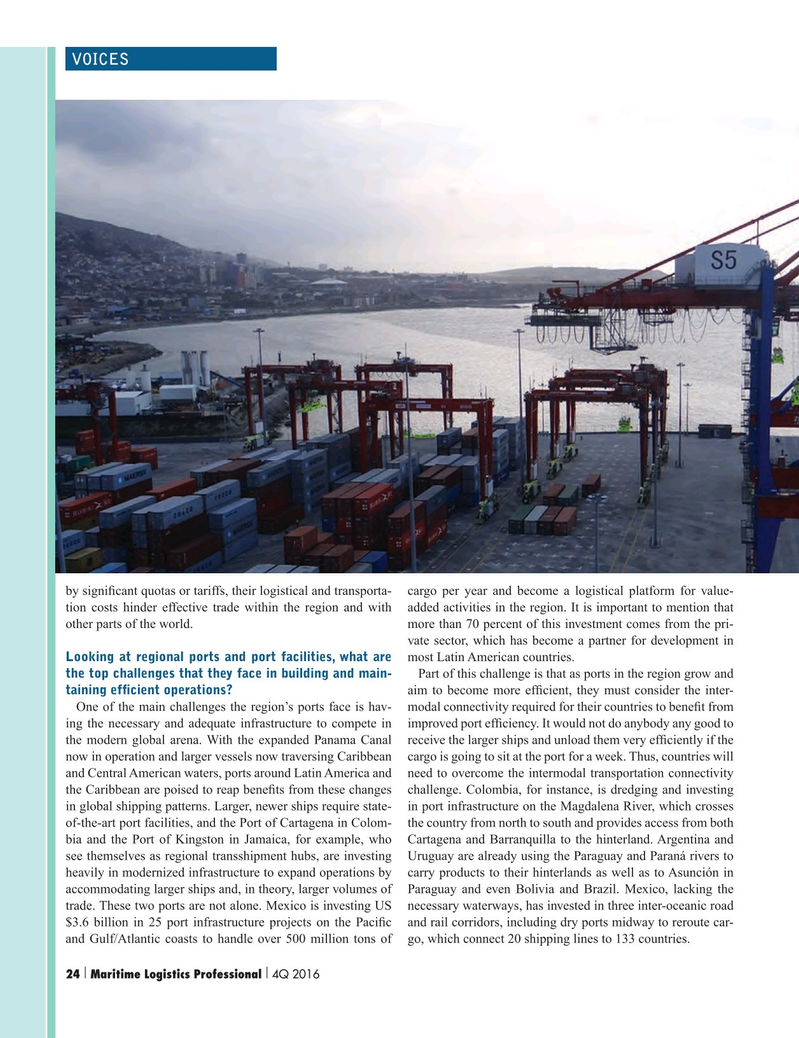
Page 24: of Maritime Logistics Professional Magazine (Q4 2016)
Workboats
Read this page in Pdf, Flash or Html5 edition of Q4 2016 Maritime Logistics Professional Magazine
VOICES by signi? cant quotas or tariffs, their logistical and transporta- cargo per year and become a logistical platform for value- tion costs hinder effective trade within the region and with added activities in the region. It is important to mention that other parts of the world. more than 70 percent of this investment comes from the pri- vate sector, which has become a partner for development in
Looking at regional ports and port facilities, what are most Latin American countries. the top challenges that they face in building and main- Part of this challenge is that as ports in the region grow and taining eff cient operations? aim to become more ef? cient, they must consider the inter-
One of the main challenges the region’s ports face is hav- modal connectivity required for their countries to bene? t from ing the necessary and adequate infrastructure to compete in improved port ef? ciency. It would not do anybody any good to the modern global arena. With the expanded Panama Canal receive the larger ships and unload them very ef? ciently if the now in operation and larger vessels now traversing Caribbean cargo is going to sit at the port for a week. Thus, countries will and Central American waters, ports around Latin America and need to overcome the intermodal transportation connectivity the Caribbean are poised to reap bene? ts from these changes challenge. Colombia, for instance, is dredging and investing in global shipping patterns. Larger, newer ships require state- in port infrastructure on the Magdalena River, which crosses of-the-art port facilities, and the Port of Cartagena in Colom- the country from north to south and provides access from both bia and the Port of Kingston in Jamaica, for example, who Cartagena and Barranquilla to the hinterland. Argentina and see themselves as regional transshipment hubs, are investing Uruguay are already using the Paraguay and Paraná rivers to heavily in modernized infrastructure to expand operations by carry products to their hinterlands as well as to Asunción in accommodating larger ships and, in theory, larger volumes of Paraguay and even Bolivia and Brazil. Mexico, lacking the trade. These two ports are not alone. Mexico is investing US necessary waterways, has invested in three inter-oceanic road $3.6 billion in 25 port infrastructure projects on the Paci? c and rail corridors, including dry ports midway to reroute car- and Gulf/Atlantic coasts to handle over 500 million tons of go, which connect 20 shipping lines to 133 countries. 24 Maritime Logistics Professional 4Q 2016| | 18-33 Q4 MP2016.indd 24 11/10/2016 10:30:48 AM

 23
23

 25
25
